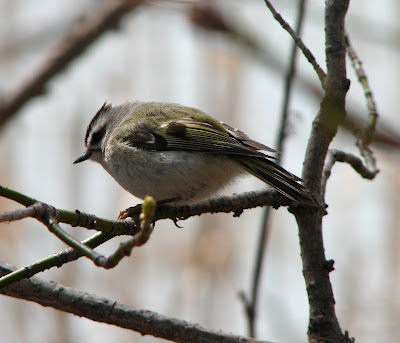Walking back to my car, I saw Golden-crowned Kinglets (Regulus satrapa) flitting in the small wooded area near the pump house. Recalling my efforts to photograph a Golden-crowned Kinglet at Belle Isle, I almost kept walking. Then, oh, what the heck, I have time - I stopped to take another chance at photos of this bird.
The first keeper - the orange crown stripe is just visible.
Another view.
In the middle of my photo shoot, I was distracted by a Brown Creeper (Certhia americana) on the next tree and took this quick shot before it disappeared around to the other side.
A little dark, but quite a good look at this bird.
A bit of sun on the subject.
Essentially the same view, but less crest and more sun.
Ah hah - there he is, golden crown and all! I thought that this bird might be a first year male. The crown was more orange-yellow.
I was wearing a green jacket and stood quietly and moved only slightly as the bird flitted around and came very close. Too close even for the 12x zoom lens.
Moving on, I found a Lesser Scaup (Aythya affinis) pair that I thought I would be able to pull in with a cropped image.
The bright plumage of the male showed up well in the sun.
Finally, I stopped to photograph a nest, probably belonging to Yellow Warblers (Dendroica petechia), that survived the harsh winter in very good condition, when something at my feet moved in the grass.
This slender Garter Snake (Thamnophis sp.) was probably 15 to 18 inches long. I pestered it for several photographs and these two turned out the best - also a quick and tricky subject.
Garter Snakes are the single most widely distributed genus of reptile in North America.
When I downloaded my photos to the computer, the immobile old Yellow Warbler nest was not in focus. Such are my trials and tribulations as a nature photographer.
The last thing I did on this outing was to check the exposed Great Horned Owl (Bubo virginianus) nest that I found enroute to Point Mouille on March 22nd (see earlier blog post.)
She's still there; today enjoying a bit of sun. No owlets can be seen yet. It seems late - is it possible she's still incubating?
This morning I saw the two Lake Erie Metropark Great Horned nests prior to doing all of the above. A parent bird from each of the two nests were perched away from the nest. The owlet at the north end of the nature trail is already developing darker feathers. The two owlets at the park entrance are still downy gray. With this in mind, I hope that all is well for the patient and diligent mom on her nest above.
Winter Wren (Troglodtes troglodytes), Hermit Thrush (Catharus guttatus) and singing Fox Sparrows (Passerella iliaca) were also on the Lake Erie Metropark Nature Trail.












No comments:
Post a Comment